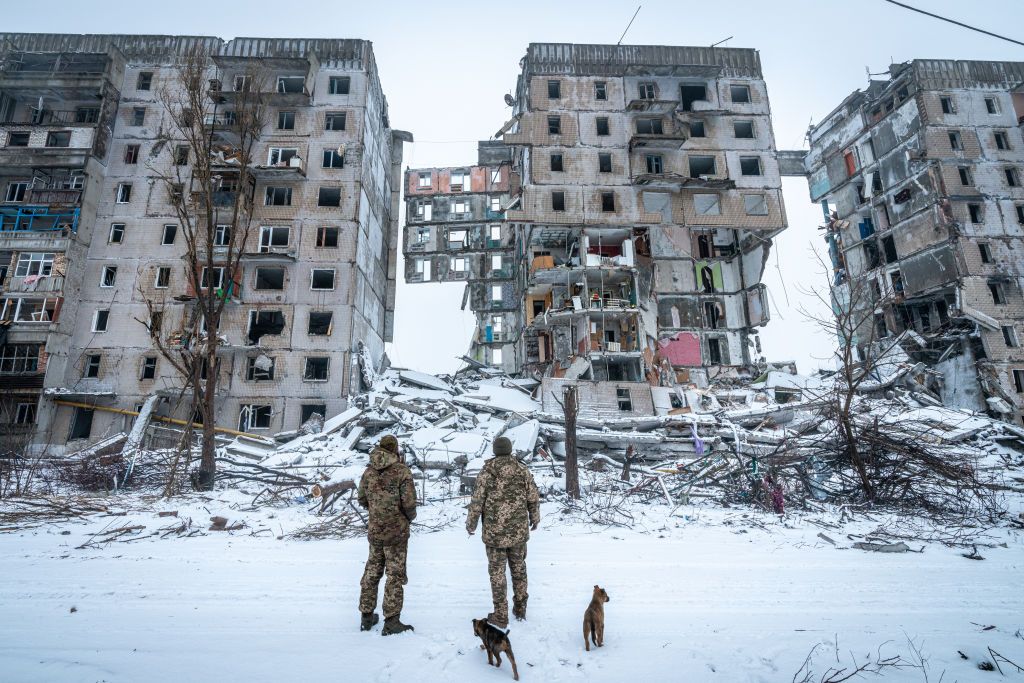
Why the West misunderstood Russia’s initial assault on Ukraine
The West's meek response to Russia's 2014 aggression in Ukraine not only prolonged the conflict but also paved the way for the devastating full-scale invasion in 2022.
A Russian soldier takes photos at the Mariupol Drama Theater, which was bombed by Russian forces on March 16, 2022, in Mariupol, Ukraine, on April 12, 2022. (Alexander Nemenov / AFP via Getty Images)
On July 17, 2014, the downing of Malaysia Airlines Flight MH-17, a commercial plane flying from Amsterdam to Kuala Lumpur, shocked the world. The crash claimed the lives of all 298 passengers and crew, including 80 children. It marked a significant escalation in Russia’s war against Ukraine that had been unfolding since early 2014.
However, this tragic incident was just one of many in a turbulent year that also saw Russia’s annexation of Crimea and its covert invasion of Ukraine's Donbas region. What followed was a hybrid war that would span nearly a decade, culminating in Russia’s full-scale invasion of Ukraine in February 2022. Understanding the events of 2014 and the West’s delayed and inadequate response offers critical lessons for interpreting the current war.
"Understanding the events of 2014 and the West’s delayed and inadequate response offers critical lessons for interpreting the current war."
The initial spark for the war can be traced to Ukraine's ambition to align itself with Europe through an Association Agreement with the European Union, which included a Deep and Comprehensive Free Trade Area. Though primarily an economic treaty, Moscow saw it as a direct challenge to its geopolitical influence in the post-Soviet space. Ukraine’s decision to sign the agreement was viewed by Russia as a threat to its efforts to keep Ukraine within its sphere of control. Moscow feared that other former Soviet states might follow suit, prompting a decisive and aggressive response.
In February 2014, Russia began its military intervention by occupying Crimea, and by March, it had formally annexed the peninsula. In April, Russian proxy troops infiltrated Ukraine’s Donbas region, sparking violent confrontations. The war in Ukraine escalated, resulting in further tragedy, including the downing of a Ukrainian Il-76 transport plane in June and MH-17 in July. The latter prompted the European Union to impose sectoral sanctions on Russia later that month.
The West’s response to the initial stages of the war was, at best, tepid. Though sectoral sanctions were introduced after the downing of MH-17, these measures came when the Ukrainian army was temporarily making gains in the Donbas. The EU’s introduction of sanctions in immediate response to the killing of EU rather than Ukrainian citizens sent an ambivalent signal. It suggested that not Russia’s aggression per se, but its collateral damages are the problem. Accordingly, in August 2014, Russia escalated its involvement in eastern Ukraine, now deploying regular troops on a large scale.
The West’s continuing reluctance to take decisive action in 2014 can be attributed to a widely spread fundamental misreading of the situation. Many in the international community, particularly in Europe, viewed the conflict as an internal Ukrainian issue that could be resolved through diplomacy. This failure to recognize the broader strategic ambitions of Russia allowed the war to drag on for over a decade.
A key reason for the West’s failure to grasp the true nature of the conflict was a lack of expertise on Ukraine and Russia’s hybrid warfare tactics. Western journalists, many of whom had spent years covering Russia, often interpreted events through a Russian lens. Russian narratives, depicting the conflict in the Donbas as a regional uprising or civil war, were widely accepted, and Western media often failed to see the larger picture of Russian interference and subversion.
Pro-Russian demonstrations and local sentiments in eastern Ukraine were taken at face value by foreign correspondents, who struggled to distinguish between genuine local movements and orchestrated Russian interventions. Moscow deployed agents from Russia and other controlled regions, such as Transnistria, to create the illusion of local support for its collaborators. Meanwhile, pro-Ukrainian voices in the Donbas were silenced through threats, violence, and abductions, often orchestrated by Russian-backed forces. Western reporters, unfamiliar with the complexities of the region, largely missed this dynamic, resulting in a skewed portrayal of the conflict in international media.
Russia’s manipulation of the conflict-resolution framework was another significant factor in the West’s delayed response. Moscow alternated between periods of overt aggression and gestures of conciliation, such as withdrawing parliamentary approval for troop deployment in Ukraine in mid-2014. This tactic, known as "escalation control," allowed Russia to exert pressure on Ukraine while maintaining plausible deniability and avoiding large-scale retaliation from the West.
By participating in peace negotiations, such as the Minsk agreements, while simultaneously violating ceasefires and continuing covert operations in Ukraine, Russia deceived many Western diplomats into believing a diplomatic resolution was still possible. The Minsk agreements, brokered in 2014 and 2015, were seen by many in the West as a step toward peace. In reality, they served Moscow’s strategy of consolidating control over the Donbas while avoiding direct confrontation with NATO.
The events of 2014 offer important lessons for understanding Russia’s broader strategy and the nature of the current war in Ukraine. One key takeaway is that the West’s piecemeal approach to Russia’s aggression — characterized by limited sanctions and delayed military support for Ukraine—only emboldened Moscow. The belief that Russia would cease its aggression if given economic incentives or diplomatic concessions has been proven wrong time and again.
The full-scale invasion of Ukraine in 2022 was the culmination of eight years of Russian aggression and Western inaction. While the West has since stepped up its support for Ukraine, providing military aid and imposing harsher sanctions on Russia, the initial misreading of the conflict in 2014 and slow reaction to Russia’s enormous aggression since 2022 allowed the war to last far longer than it might have.
Moving forward, the international community must learn from past mistakes and adopt a more assertive and strategic approach to dealing with Russian aggression. Addressing the root causes of the conflict and providing Ukraine with the necessary support are essential to achieving a lasting and secure peace. Based on the lessons of the 2014-2022 war in the Donbas, four key policy recommendations emerge:
First, recognizing the "Russia Problem": The West must recognize that the current war is not a “Ukraine crisis” but a manifestation of Russia’s imperialist ambitions. The root cause lies in Moscow’s revisionist policies, not any internal Ukrainian issues.
Second, military support for Ukraine: As meaningful negotiations with Russia are currently impossible, the West must increase its military support to Ukraine. This will empower Kyiv to negotiate from a position of strength, ensuring that any future peace talks lead to a lasting resolution rather than a partial de-escalation followed by later re-escalation.
Third, countering Russian disinformation and hybrid warfare: Western governments must allocate more resources to countering Russia’s disinformation campaigns and hybrid warfare tactics. This includes developing whole-of-society counterstrategies to defend against Russia’s subversive activities and propaganda.
Strengthening deterrence: Any future peace agreement must include serious security guarantees and strong military deterrents to prevent Russia from using a temporary truce to prepare for another attack. NATO and the European Union must lead a united, robust response to any further Russian aggression.
Editor’s Note: The opinions expressed in the op-ed section are those of the authors and do not necessarily reflect the views of the Kyiv Independent. This article is based on the more extensive September 2024 SCEEUS report.
Stay warm with Ukrainian traditions this winter. Shop our seasonal merch collection.















